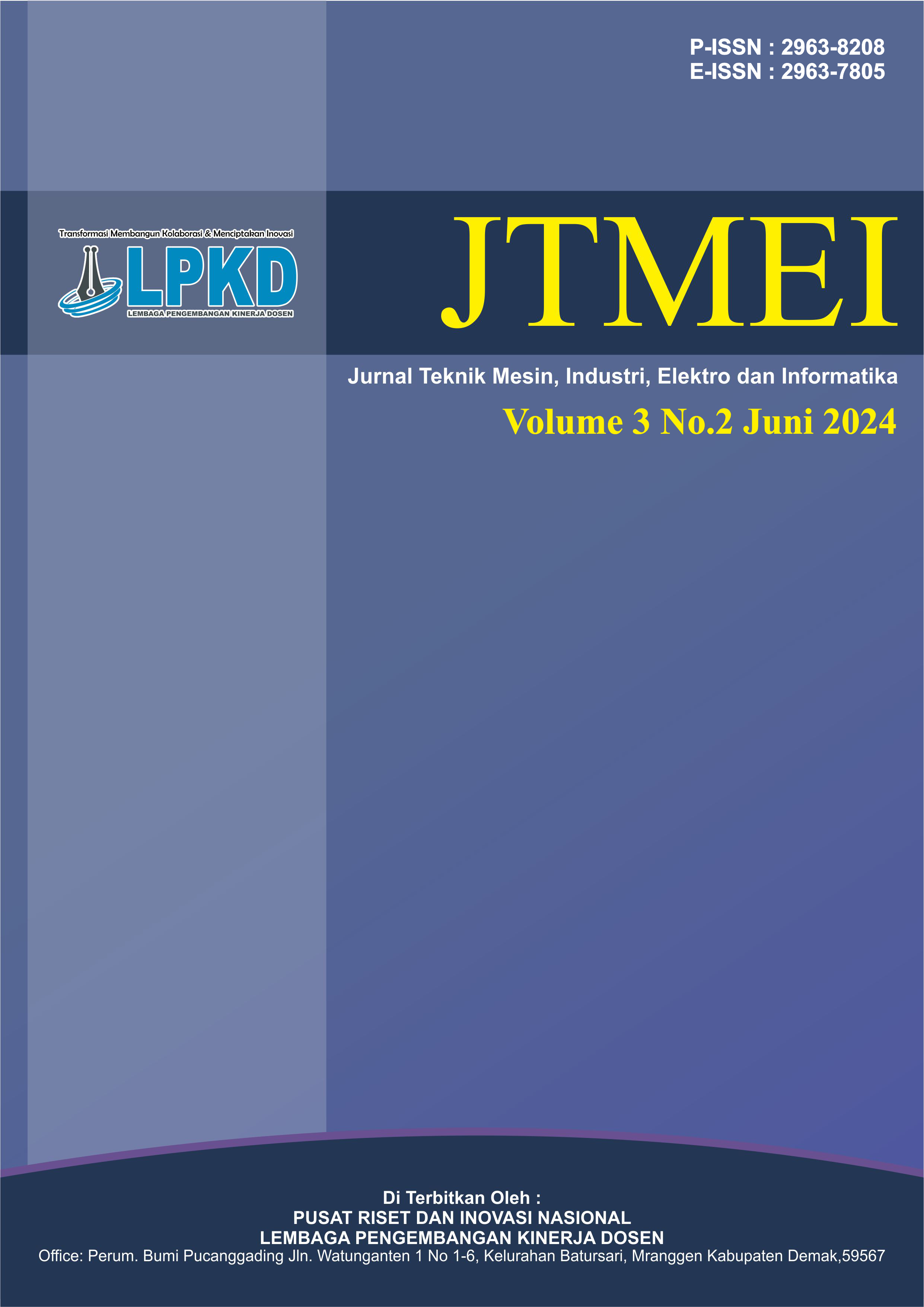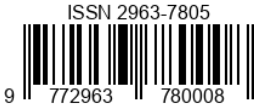Pengaruh Variasi Proses Pirolisis Terhadap Nilai Kalor Biopelet Berbahan Baku Sabut Kelapa
DOI:
https://doi.org/10.55606/jtmei.v3i2.3958Keywords:
Coconut fiber, pyrolysis process, biopellets, new renewable energyAbstract
Biopellets can be used as a heat generator in private homes and small businesses. Biopellets are made by compressing and molding with adhesive. Based on this composition, it shows that coconut fiber has the potential to be used as biopellet charcoal fuel. However, the calorific value of coconut fiber is still relatively low. The way to increase the calorific value of coconut fiber is through the pyrolysis process. The advantage is also that it reduces the water content of the product, making it less likely to absorb moisture from the air. One use of charcoal produced from the pyrolysis process of coconut fiber as household or industrial fuel is as biopellets. The method used in this research is an experimental method on the effect of variations in the temperature of the pyrolysis process made from coconut fiber in making biopellets to determine the effect of variations in pyrolysis temperature, namely 300°C, 350°C and 400°C on the calorific value, the effect of variations on fixed carbon, and burning rate of coconut fiber biopellets which can be used as an alternative energy source.
Downloads
References
Al Qadry, M. G., Saputro, D. D., & Widodo, R. D. (2023). Karekteristik dan uji pembakaran biopelet campuran cangkang kelapa sawit dan serbuk kayu sebagai bahan bakar alternatif terbarukan. Jurnal Inovasi Mesin, 5(1), 21–29.
Asri, A., & Sari, Y. P. (2022). Evaluasi kecernaan bahan kering bahan organik dan protein kasar kombinasi jerami padi dan Tithonia fermentasi secara in-vitro. Jurnal Peternakan Mahaputra, 3(2), 99-107.
Barus, K. E., Munir, A. P., & Panggabean, S. (2017). Pembuatan briket dari sekam padi dengan kombinasi batubara. Jurnal Rekayasa Pangan dan Pertanian, 5(2), 397-401.
Basu, P. (2018). Biomass gasification, pyrolysis and torrefaction: Practical design and theory. Academic Press.
Caturwati, N. K., Sudrajat, A., Haryanto, H., Pinem, M. P., & Reza, R. (2017). Energi dan mesin konversi energi. Jurnal Teknik Mesin Untirta, 1(1).
Dewi, R. P., Arnandi, W., Purnomo, S. J., & Saputra, T. J. (2019). Pengaruh variasi konsentrasi perekat terhadap kadar fixed carbon dan volatile matter bricket arang. Dalam Prosiding SNST ke-3 Fakultas Teknik Universitas Wahid Hasyim (hal. 45–50).
Erwin Junary, J. P. Pane, & N. Herlina. (2015). Pengaruh suhu dan waktu karbonisasi terhadap nilai kalor dan karakteristik pada pembuatan bioarang berbahan baku pelepah aren (Arenga pinnata). Jurnal Teknik Kimia USU, 4(2), 46–52.
Herlambang, S. (2020). Prosiding seminar nasional fakultas pertanian UPN 'Veteran' Yogyakarta 2020. Prosiding Seminar Nasional, 372–373.
Hidayati, B., Baiti, & Sumarna, H. (2019). Prototipe pengering bahan baku dan produk biopelet ditinjau dari energi H2O yang teruapkan ke udara. JurnalPETRA, 6(2), 29–33.
Huseini, A., Ulfa, A. M., & Sulaimansyah, S. (2018). Analisis proksimat, kandungan sulfur dan nilai kalor dalam penentuan kualitas batubara. Indonesian Journal of Engineering (IJE), 1(2), 85–94.
Iriany, R., Hasibuan, R., Novita, D., & Ummah, N. M. (2023). Pengaruh komposisi bahan baku dan ukuran partikel terhadap kualitas biobriket dari cangkang buah karet dan ranting kayu. Jurnal Teknik Kimia USU, 12(1), 1–8.
Jerami, A., Abstrak, & Sebelum, C. (2023). C. Sebelum dilakukan pirolisis, jerami padi dianalisis FTIR untuk mngetahui gugus fungsi yang terdapat didalamnya. Jurnal, 8*(3), 167–172.
Khusaini, F., Ridwan, R., Ridhuan, K., & Irawan, D. (2021). Pengaruh jumlah pipa udara pada reaktor pembakaran pirolisis terhadap hasil arang dan asap cair. ARMATUR: Artikel Teknik Mesin & Manufaktur, 2(2), 106–114.
Kuncoro, A. H. (2017). Uji potensi pembuatan briket bioarang dari ladek sebagai bahan bakar alternatif. Al Jazari Journal of Mechanical Engineering, 2(2), 22–34.
Lehmann, J., & Joseph, S. (Eds.). (2015). Biochar for environmental management: Science, technology and implementation. Routledge.
Lestari, L., Hasan, E. S., & Risna, R. (2017). Pengaruh tekanan dan ukuran partikel terhadap kualitas briket arang cangkang coklat. Jurnal Aplikasi Fisika, 13(2), 1-8.
Mardiatmoko, G., & Mira, A. (2018). Gun Mardiatmoko. Ambon: Badan Penerbit Fakultas Pertanian Universitas Pattimura.
Nurhilal, O., & Suryaningsih, S. (2018). Pengaruh komposisi campuran sabut dan tempurung kelapa terhadap nilai kalor biobriket dengan perekat molase. JIIF (Jurnal Ilmu dan Inovasi Fisika), 2(1), 8-14.
Onchieku, J. M., Chikamai, B. N., & Rao, M. S. (2012). Optimum parameters for the formulation of charcoal briquettes using bagasse and clay as binder. European Journal of Sustainable Development, 1(3), 477.
Parinduri, L., & Parinduri, T. (2020). Konversi biomassa sebagai sumber energi terbarukan. Journal of Electrical Technology, 5(2), 88–92. https://www.dosenpendidikan.
Paskawati, Y. A., Susyana, A., Antaresti, & Retnoningtyas, E. S. (2010). Pemanfaatan tempurung kelapa sebagai bahan baku pembuatan kerta komposit alternatif. Widya Teknik, 9(1), 12–21.
PERMANADEWI, E. F., & INGGRIANI, P. (2020). TA: Pengaruh jumlah bahan perekat, suhu, dan waktu operasi pada pembuatan bahan bakar padat dari limbah budidaya jamur (LOG) dengan proses torefaksi. (Doctoral dissertation, Institut Teknologi Nasional Bandung).
Ridhuan, K., Irawan, D., & Inthifawzi, R. (2019). Pyrolysis combustion process with biomass type and characteristics of the liquid smoke produced. Turbo, 8(1), 69–78.
Saparudin, S., & Nurchayati. (2015). The effect of pyrolysis temperature variation to levels of yield and calorific value of the mixture rice husk briquettes – chicken manure. Dinamika Teknik Mesin, 5(1), 16–24.
Seminar, P., & Apta, N. (2016). Digital digital repository repository Universitas Universitas Jember Jember SEBAGAI BAHAN BAKAR RUMAH TANGGA Digital digital repository repository Universitas Universitas Jember Jember. (C), 233–234.
Sinta Rismayani, S., & Tayibnapis, A. S. (2011). Pembuatan bio-briket dari limbah sabut kelapa dan bottom ash. Arena Tekstil, 26(1).
Suhartoyo, Y., Kristiawan, Y., et al. (2020). Pemanfatan limbah biomassa menjadi sumber energi alternatif. Jurnal Crankshaft, 3(2), 23–28.
Sulistio, Y., et al. (2020). Pengaruh torefaksi dengan reaktor counter-flow multi-baffle (COMB) dan electric furnace terhadap pelet kayu jabon (Anthocephalus cadamba). Jurnal Sylva Lestari, 8(1), 65–76.
Vegatama, M. R. (2022). Perbandingan nilai kalor biobriket dengan variasi komposisi bahan baku limbah biomassa. Journal of The Indonesian Society of Integrated Chemistry, 14(2), 77–83.
Yuniarti, Y., Ariyani, D., & Megawati, E. (2019). Pengaruh heating rate terhadap karakteristik nilai kalor limbah kulit buah nipah (Nypa fruticans (Thunb.) Wurmb) pada proses slow pirolisis. Petrogas: Journal of Energy and Technology, 2(2), 62–68.
Downloads
Published
How to Cite
Issue
Section
License
Copyright (c) 2024 Jurnal Teknik Mesin, Industri, Elektro dan Informatika

This work is licensed under a Creative Commons Attribution-ShareAlike 4.0 International License.








